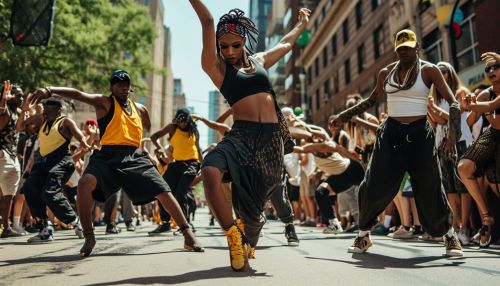Hip hop dance
Origins and History
Hip hop dance, a genre of dance that originated within the African American and Latinx communities of the Bronx, New York, in the 1970s, is an integral part of the hip hop culture. The dance style was born out of social and political struggles, serving as a form of expression and resistance. It has since evolved and spread globally, influencing and being influenced by other dance forms.


The roots of hip hop dance can be traced back to traditional African dances and the influence of the African diaspora. The dance style was also heavily influenced by Latin dance styles, particularly those from Puerto Rico and Cuba. The emergence of hip hop dance coincided with the birth of hip hop music, with DJs such as Kool Herc playing a key role in its development.
Styles
There are several distinct styles within hip hop dance, each with its own unique characteristics and techniques.
Breaking
Breaking, also known as b-boying or breakdancing, is one of the earliest and most iconic styles of hip hop dance. It involves acrobatic moves, intricate footwork, and stylized poses. Breaking is typically performed to breakbeats, a type of music with a rhythmic pattern that originated from funk and soul music.
Popping
Popping is a style of hip hop dance that involves quick, jerky movements of the muscles, creating a popping or snapping effect. It was developed in the late 1970s in Fresno, California, by a dancer known as Boogaloo Sam. Popping often incorporates elements of mime and illusion, with dancers creating the impression of robots or mannequins.
Locking
Locking is a funk style that was developed in the late 1960s by Don Campbell in Los Angeles. It involves fast, sharp movements followed by a freeze or "lock". Locking often includes acrobatics and theatrical elements, with dancers often interacting with the audience.
Krumping
Krumping is a relatively recent style of hip hop dance that emerged in the early 2000s in South Central Los Angeles. It is characterized by aggressive movements, high energy, and expressive freestyle. Krumping often serves as a form of emotional release and is closely tied to community and spirituality.
Cultural Significance
Hip hop dance has played a significant role in shaping culture and society, both within and beyond the communities where it originated. It has provided a platform for marginalized groups to express their experiences and perspectives, challenging social norms and power structures.
The dance style has also had a profound impact on popular culture, influencing fashion, film, and advertising. It has been embraced by mainstream media and entertainment, with hip hop dance routines featuring in music videos, movies, and television shows.
Education and Training
While hip hop dance was initially learned and passed down informally within communities, it has since been incorporated into formal dance education. Many dance studios and schools now offer hip hop dance classes, and there are numerous competitions and events that provide opportunities for dancers to showcase their skills and learn from others.
In addition to formal training, many hip hop dancers continue to learn and develop their skills through street performances, dance battles, and social media platforms.
Health Benefits
Hip hop dance offers numerous health benefits. It is a form of aerobic exercise that can improve cardiovascular health, strength, flexibility, and coordination. It can also contribute to mental health, providing a creative outlet and a means of self-expression, and can help to reduce stress and improve mood.
